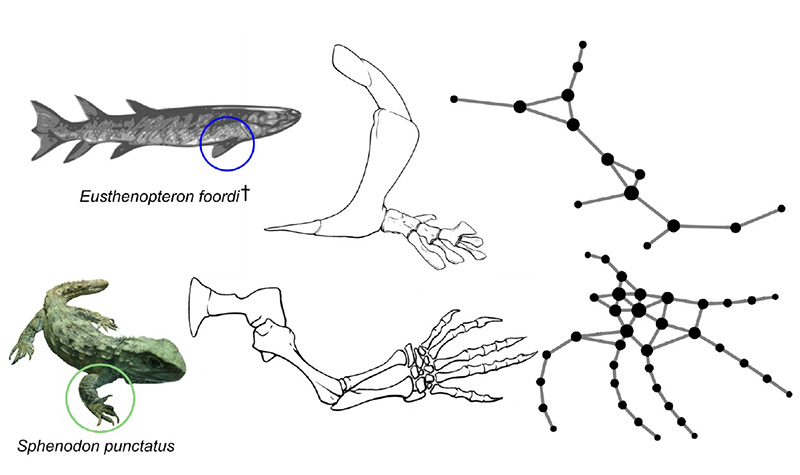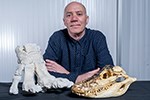New study explains how fish got their fingers
New analysis of anatomical evidence shows how the limbs of land vertebrates (such as mammals and reptiles) originated from the fins of water-bound fishes.
Their findings, published in Science Advances today, provide an answer to the mystery behind the origins of fingers and toes – which is one of the greatest evolutionary questions.
The study was conducted by an international team of researchers. The team, led by two scientists from the Royal Veterinary College, also included the expertise of academics from Harvard University, The University of Auckland, New York Institute of Technology, and Howard University.
The team bridged the gap between the anatomy of fins and the limbs of extinct fossil animals by using a cutting-edge mathematical analysis of the anatomy. Their approach also differed from the conventional tools used to study evolutionary history because their model emphasised analysing the joints between bones. This tactic revealed how the complexity of bone arrangements has decreased during the transition from fins to limbs. What was also particularly notable was that this decreased complexity coincided with the number of bones and joints increasing.

It was also found that the variety of connections between bones had been decreasing until the first suspected reports of four-limbed vertebrates, roughly 400 million years ago. The team has suggested that because the variety did not increase after this time, there must have been an evolutionary compromise between the ancient developmental controls (shared by fins and limbs), and the new biomechanical demands that were required for walking on limbs.
The research was primarily funded by the European Union’s Horizon 2020 research and innovation program, via a Marie Skłodowska-Curie fellowship to Dr. Esteve-Altava.
Dr Borja Esteve-Altava, who did the research at the RVC but now works at the Institute of Evolutionary Biology in Barcelona, commented: “Modelling fins and limbs as networks of connected bones has allowed us to quantify and compare the anatomy of these two related, but very different, structures in a way that is not accessible to other current methods of measuring anatomy.”
Dr John Hutchinson, Professor of Evolutionary Biomechanics at the RVC, commented: “One of the exciting findings of this innovative study is that limbs have more what we call “modularity” than fins do—some parts of the limbs are more associated with each other, forming an exclusive ‘club’ of interactions. That modularity enabled many later specializations, such as the mobility of our fingers to type on keyboards vs. the rigidity of our toes to walk with.”
Dr Stephanie E. Pierce, Associate Professor of Organismic and Evolutionary Biology and Curator of Vertebrate Paleontology in the Museum of Comparative Zoology at Harvard University, also remarked: “Although the connections between bones became simplified as fins evolved into limbs, the evolution of hands with fingers and feet with toes provided the necessary platform for walking, allowing our early ancestors to leave their watery sanctuary for life on land.”
Notes to Editors
For more information please contact:
- Alex Cassells (alexander.cassells@plmr.co.uk) or Ploy Radford (ploy.radford@plmr.co.uk)
- Press Line: 0800 368 9520
About the RVC
- The Royal Veterinary College (RVC) is the UK's largest and longest established independent veterinary school and is a constituent College of the University of London.
- The RVC is ranked as the world’s number one veterinary school in the QS World University Rankings 2019.
- The RVC offers undergraduate, postgraduate and CPD programmes in veterinary medicine, veterinary nursing and biological sciences.
- It is currently the only veterinary school in the world to hold full accreditation from AVMA, EAEVE, RCVS and AVBC.
- In 2017, the RVC received a Gold award from the Teaching Excellence Framework (TEF) – the highest rating a university can receive.
- A research-led institution, the RVC maintained its position as the top veterinary institution in the Research Excellence Framework (2014), with 79% of its submission being rated as world-class or internationally excellent.
- The RVC also provides animal owners and the veterinary profession with access to expert veterinary care and advice through its teaching hospitals: the Beaumont Sainsbury Animal Hospital, in central London, and the Queen Mother Hospital for Animals (Europe's largest small animal referral centre) and Equine Referral Hospital, both located at the Hertfordshire campus.
You may also be interested in:
-
RVC’s Professor John Hutchinson elected Fellow of prestigious Royal Society
John Hutchinson, Professor of Evolutionary Biomechanics at the Royal Veterinary College (RVC), has …

